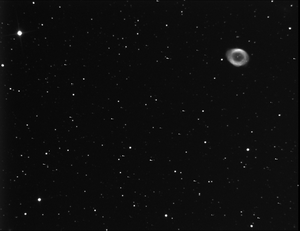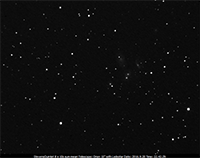Live Stacking
Starlight Live is a Electronically Assisted Astronomy (EAA, more about it here) real-time stacking software developed by Paul Shears and available (for free) from Starlight Xpress. It works only with their cameras, but I already own Lodestar guider.
The software is very straightforward to install, and there is a tutorial available online (written originally for Lodestar Live, but updated) providing loads of info.
I think my way into Live Stacking is a typical one for someone already engaged in amateur astronomy, so I will follow it exactly as it was.
Initially I have chosen my 10" Newtonian (Orion) on CGE mount. It is already set up and connected and works well for imaging. Lodestar field of view with this scope looks reasonable (17.7'x14.0'), especially for smaller targets. The mount is controlled via serial connection to Celestron hand controller. The software used to control the mount was The Sky X (of course Celestron software that comes with CGE would also work, but I use The Sky X everywhere).
 My first EAA observing was done on M57 with no special fine-tuning, just
slew and go. The result is on the left, and I think it is amazing. It
worked exactly as it supposed to, got fantastic details, and took only a
few minutes.
It is easy to get better, too. The software supports darks, hot pixel
removal and non-linear processing. I have started to use darks, usually
I take them all at the beginning and save to disk, one for each exposure
length. The next time I have used C14 Hyperstar, and the results were even better
(see Pictures 2). Faster C14 Hyperstar
optics allowed for shorter exposures and fainter targets, generally
producing more details.
My first EAA observing was done on M57 with no special fine-tuning, just
slew and go. The result is on the left, and I think it is amazing. It
worked exactly as it supposed to, got fantastic details, and took only a
few minutes.
It is easy to get better, too. The software supports darks, hot pixel
removal and non-linear processing. I have started to use darks, usually
I take them all at the beginning and save to disk, one for each exposure
length. The next time I have used C14 Hyperstar, and the results were even better
(see Pictures 2). Faster C14 Hyperstar
optics allowed for shorter exposures and fainter targets, generally
producing more details.
 The easiest way to stack is "sum" method, each image is being added to
the results as it comes, mathematically it is equivalent to average for
noise reduction, but it increases the brightness. One needs to be
careful here, if too many are summed it is possible to exceed maximum
brightness in many areas of the picture resulting in loss of detail. For
best results I used "sum and mean" protocol - first N frames are added,
then each subsequent batch of N is summed and then the result averaged
with the main image. This way first the desired brightness is achieved,
then the noise reduced. I found that in most cases just adding 10-20
8-10sec frames is enough for 10" and 6-8 6sec is enough for C14
Hyperstar, but sometimes, especially for faint targets low
noise is important (e.g. Helix Nebula and Horsehead Nebula in
Pictures 2). The effect is shown on the Steven's Quintet animation
on the left. Noise can be also reduced using mean (3x3 or 5x5) or low
pass (same) filters, but I feel they blur the image too much, so I did
not use them.
The easiest way to stack is "sum" method, each image is being added to
the results as it comes, mathematically it is equivalent to average for
noise reduction, but it increases the brightness. One needs to be
careful here, if too many are summed it is possible to exceed maximum
brightness in many areas of the picture resulting in loss of detail. For
best results I used "sum and mean" protocol - first N frames are added,
then each subsequent batch of N is summed and then the result averaged
with the main image. This way first the desired brightness is achieved,
then the noise reduced. I found that in most cases just adding 10-20
8-10sec frames is enough for 10" and 6-8 6sec is enough for C14
Hyperstar, but sometimes, especially for faint targets low
noise is important (e.g. Helix Nebula and Horsehead Nebula in
Pictures 2). The effect is shown on the Steven's Quintet animation
on the left. Noise can be also reduced using mean (3x3 or 5x5) or low
pass (same) filters, but I feel they blur the image too much, so I did
not use them.
Several things can be done to improve EAA experience. First - get a sensitive color CCD camera, preferably with larger sensor than Lodestar. Starlight Xpress Ultrastar Color fits the bill perfectly here, and it is on my buy list now. Second - make all steps work with electronic, without a need to go outside to the telescope. In order to align the mount, or correct imprecise slew one needs an electronic finder scope. I got one from Orion and mated with my Orion StarShoot Autoguider. The finder scope comes with an attachment that allows the scope to be mounted on a standard photographic tripod adapter, therefore it works both with Orion 10" Newtonian (replaces regular finder scope) and C14 (with a camera adapter on the top).
Below are all my EAA session pictures with comments organized by sessions.
Pictures 1. September 12-22 2016 (Orion 10" Newtonian on CGE with Lodestar).
Pictures 2. September 27 2016 (Celestron C14 Hyperstar on CGE with Lodestar). Revisited some targets from 9/12-22 to compare and more.
Pictures 3. October 6 2016 (Celestron C14 Hyperstar on CGE with Lodestar).
Pictures 4. November 8 2016 (Lodestar on Canon 17-85mm lens).
Pictures 5. September 10 2018 (Ultrastar Color with C14 Hyperstar).
Pictures 6. November 8 2018 (Ultrastar Color with Orion 10" Newtonian).
Pictures 7. November 8 2018 (Ultrastar Color with Orion 10" Newtonian).
Pictures 8. September 5 2019 (Ultrastar Color with C14 Hyperstar).
Pictures 9. September 26 2019 (Ultrastar Color with C14 Hyperstar, Black Forest Star Party).
Pictures 10. October 23 2019 (Ultrastar Color with C14 Hyperstar).